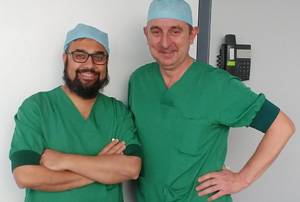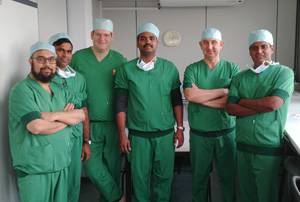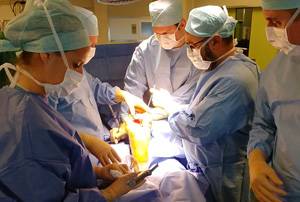Invited to the university of Sharjah on the 1st and 2 nd of march 2016 as an examiner for the prestigious MRCS ( Member of the Royal College of Surgeons) conducted by the Royal College of Surgeons, England.
Al Hujj Hospital Karabala
Senior Surgeon visitation program in revision knee replacement surgery to ZNA Middelheim University Hospital Ortho Dept, Antwerp, Belgium. Jan 2018.
Jehangir Hospital saves “Maharashtra Kesari” from “Kushti Arthritis” ( 2 Feb 2015, TGIN News 24x7)

Jehangir Hospital saves “Maharashtra Kesari” from “Kushti Arthritis” Every human being experiences a blissful and a happy life during a cheery span of time. A person experiences gracefulness in the absence of apprehension, sorrow and unhealthy condition. But life becomes regretful when someone fails or goes through difficult circumstances. There are numerous people undermining such obscurity, one of them was Mr. Ganpat Kadam a dynamic and a hardworking wrestler.
He was a professional wrestler in his youth who made his hobby as a career, breathing an enthusiastic and a joyful life. The most gracious moment was when he won the prestigious “Maharashtra Kesari”, a wrestling title in 1982. He resided in the Bhadalwadi village, approx 120 km from Pune. He retired from wrestling in 1990 and then started farming. All his aspirations and hopes went in vain while he suffered from multiligamentous injury to his left knee in 1984.This happened while undergoing training. He was treated by a local doctor under temporary medication. It worsened the case as he was not financially stable to undermine a treatment. The injury became so dreadful that it restrained the complications until surgery. Due to the forceful pressure on the left knee he damaged his right knee as well. His knees continued to worsen and he could barely walk.
Dr. Murtaza Adeeb
FRCS (ORTH), DIP (Sports MED.), MRCS, MBBS
It was almost after 20 years later he decided to implement a treatment that could impede his sufferings finally. He claimed that the villagers had misguided him all these years with a false declaration that a surgery will cause a major threat thwarting him to walk. He consulted several orthopedic surgeons .But nothing could save him as there was no much improvement. Under recommendation he was finally seen by Dr. Murtaza Adeeb, Consultant Orthopaedic and Joint Replacement Surgeon at Jehangir Hospital, Pune. After the consultation, it was observed that both his knees had completely worn out and were quite unstable. Almost three of his ligaments were torn causing Arthritis. He underwent total knee replacement surgery also known as complex replacement surgery.
“After the surgery, his condition is perfectly well and is capable to walk comfortably without any pain. There is a speedy improvement in him due to his athletic efforts taken all these years. These kinds of cases are hardly examined in India and are commonly called as Sports Arthritis. It occurs mostly with sports athletes due to over –exercises and exertion. I would like to congratulate and thank the entire team of Jehangir Hospital for its kind support and efforts for the successful surgery. I would like to call this treatment as “Kushti Arthritis”, said Dr. Murtaza Adeeb.
It is quite rare to see a patient with such severe osteoarthritis secondary to ligament injuries during wrestling and that too in both knees. The surgeries itself are quite complicated giving the severity of the arthritis and the ligament damage. This kind of surgery is called complex primary arthroplasty and needs special expertise to perform and require instrumentation and implants normally used in revision surgery. “I would like to thank the entire team of Jehangir Hospital to bring back the stability in me to stand on my own feet. Now I can proudly convey a message to the villagers about the significance of the operation. It is a lesson for the villagers to learn about science and technology”, said Mr. Ganpat Kadam.
“Jehangir hospitals responsibilities do not end just with an admission of a person but an appropriate conduct of the entire problem has to be examined. We study the patient in detail along with proper guidance and facilities. We have number of doctors catering to various specializations. And in this case, Dr. Murtaza Adeeb was the ideal mentor”, said Dr. Manisha Bobade, Medical Director.
Hip dysplasia surgery performed on 18-year-old ( 17 Jul 2012, Agency: The Times of India )
The treatment in adults with asymptomatic congenital dislocation of the hip is a total hip replacement and sometimes even a fusion of the hip joint (arthrodesis).
“A total hip replacement in this situation is potentially a very complicated operation because often there is severe shortening of the leg, the socket is flat and the bones are not well developed. Also, the muscles around the hip are not functioning normally because there is essentially no hip joint,” said orthopaedic and joint replacement surgeon Murtaza Adeeb, who carried out the surgery on the girl at Inamdar Hospital on June 27. The girl was discharged after a complete recovery on July 4.
Surgery for this condition is carried out at very specialised hospitals around the world because of the required technical skills and the specialised instruments need, he added.
“The girl had undergone two resconstructive operations in the past without much success. Her affected leg was approximately 5-6 cm shorter and she walked with a very obvious limp,” said Adeeb. “After the surgery, the girl has a brand new hip. Her leg is now the correct length and she can walk normally.”
Asked why the girl had decided to come to Pune to fix the birth defect, Adeeb said, “There are lot of Yemeni students studying in Pune. The girl came to Pune through reference from them. Besides, Pune has emerged as a recognised centre for complicated surgery and people from foreign countries routinely come for treatment here.”
The girl was admitted to the Inamdar Hospital on June 25. “Her X-rays revealed a very flat cup (acetabulum) and a very thin thigh bone (femur). Further investigations included a CT scan to get the exact measurements of the bony structure in order to get the appropriate instruments and implants,” said Adeeb.
The surgery involved identifying the area where the hip socket should be. The doctors did this by careful dissection of soft tissues surrounding the hip joint. They also used intra-operative X-rays to identify margins of the missing hip socket.
“Once we identified the area for the socket, we started preparing the socket by gently reaming the bone and we created the socket using the reamers. After reconstructing the bone socket, which had never developed since childhood, we put a metal cup in the reconstructed socket,” said Adeeb.
Then doctors addressed the femur bone. “Here we had to partially cut soft tissues around the femur to bring it down to the level of the newly-constructed socket. We then had to prepare the femur which involves preparing the passage to receive the femoral components which is composed of a stem and a ball that sits on the stem.
Since the girl had a congenital defect, the femur was very narrow and a special stem had to be ordered to fit her size. After preparing the femur, we fixed the femural stem and put the ball into the socket, thereby creating a new hip joint,” said Adeeb, who was assisted in the surgery by orthopaedic surgeon Manoj Todkar.Congenital dysplasia of the hip is a dislocation of the hip joint that is present at birth. The condition is found in babies or young children.
“This condition is seen in newborn infants wherein the hip is out of the joint at birth. The basic problem is that the cup part of the hip joint [acetabulum] is not well rounded and is flat and this causes the hip to dislocate out of the joint. If this is detected at birth, the treatment is a special restraining splint for the legs which keeps the hip in joint,” Adeeb said.
Elaborating, he said, “This splint has to be worn by the baby for at least one year. If the condition is missed at birth, various operations can be done to try and reduce the hip back in while the child is still very young. If the condition is completely missed or if the initial treatment is not successful, the child grows up with a dislocated hip. This causes a shorter leg with limited movements and pain,” he said.
Badly Deformed Knees Were Bent Outwards, A Rare Condition Surgically Difficult To Treat ( 11 jan 2012, Times of India)
A 70-year-old Nigerian woman underwent replacement surgeries on both knees at the same time in a city hospital recently.This is the first surgery of its kind ever performed in Pune. What makes the surgery unique is that as against the conventional approach,where the same surgeon operates on both knees one after another,this time,two different surgeons operated on both knees at the same time.The total knee replacement was done in one and half hours.This not only helped cut down operation time by half,but also reduced the cost and complications involved in long lasting surgeries.
The woman,Helena Ekene Okafor,had badly deformed knees that were bent outwards,a condition which is quite rare and surgically very difficult to treat.She had severe pain in both knees for almost 12 years.Doctors in Nigeria advised a total knee replacement surgery for both knees.She came to Inamdar Hospital through a medical tourism company based in India. “If the patient is deemed fit,a truly simultaneous bilateral total knee replacement surgery reduces the overall cost and patient’s stay in hospital.In some scientific papers,this has been shown to have reduced complications as compared to sequential and staged bilateral knee replacement surgery.This is the first time that this kind of an operation was carried out in Pune,”said senior joint replacement surgeon Murtaza Adeeb,who performed the surgery with joint replacement surgeon Manoj Todkar,at Inamdar Hospital,on November 19.The woman was discharged after eight days on November 28.
To ensure a good result,a team of able surgeons,physician,anaesthetist,nursing staff and a well-equipped hospital are equally important,Adeeb said. In a sequential operation,a surgeon replaces the first knee and then takes the second knee during the same anaesthetic time.”This exposes the patient to anesthesia for double the time and the instruments are also exposed to the air for longer period,”said Adeeb.A staged operation involves performing two surgeries in a gap of a few days or a few weeks.This involves two separate theatre sessions which subsequently increases cost. “The truly simultaneous bilateral total knee replacements promote symmetrical rehabilitation of both knees,thus potentially reducing the length of the hospital stay and thereby the hospital costs,”said Todkar. The average intra-operative blood loss during bilateral knee replacement is less than 500 ml which is bearable. However,one reservation about doing simultaneous bilateral total knee replacement surgery is whether releasing tourniquet (devices fitted in to prevent blood flow) will overload the heart. “We ruled out this by evaluating patient cardiac system before surgery and also released the tourniquet one after another within a gap of 20 minutes,”Adeeb said. Possibility of infections is the main challenge during a knee replacement surgery.”Usually,when the same surgeon undetakes operation on both the knees,the instrument remains exposed for longer period of time and this increases the chances of infection.However,when two surgeons are operating on both knees at the same time,the chances of infections are significantly reduced,”said Adeeb. “Such surgeries are physically very demanding and should only be done in cases where the physician has deemed the patient fit to undergo such a surgery.In case of the Nigerian woman,we had assessed her thoroughly in terms of her general medical fitness,particularly cardiac and respiratory systems.After we found her fit,the surgeons went ahead with the procedure,”said physician Abbas Chopdawala.
What Is Simultaneous Bilateral Total Knee Replacement Surgery
Both knees are replaced sequentially one after another or two-knee replacements a few days or weeks apart * When the same surgeon replaces both the knees one after another,it is called sequential bilateral total knee replacement surgery,sometimes wrongly termed as simultaneous bilateral total knee replacement surgery * A truly simultaneous bilateral total knee replacement surgery is one where two joint replacement surgeons operate on both knees at the same time ll Reduces the overall cost and patient-stay in hospital ll Complete anaesthetic state is reduced by half ll Some scientific papers say it reduces complications as compared to sequential and staged bilateral knee replacement surgery ll The chances of infections arising from surgical instruments are significantly reduced ll Such surgeries are physically demanding and should only be done in cases where the physician has deemed the patient fit to undergo the surgery (Source: Orthopaedic surgery department,Inamdar Hospital,Hadapsar) We ruled out this by evaluating patient cardiac system before surgery and also released the tourniquet one after another within a gap of 20 minutes
Murtaza Adeeb | SURGEON
Such surgeries are physically very demanding and should only be done in cases where the physician has deemed the patient fit to undergo such a surgery.In case of the Nigerian woman,we had assessed her thoroughly in terms of her general medical fitness,particularly cardiac and respiratory systems.After we found her fit,the surgeons went ahead with the procedure
Pune doctors perform rare high-risk surgery ( 10 Jul 2011, Agency: DNA)
Doctors at Pune-based Jehangir Hospital have performed a successful hip replacement surgery on 20-year-old Chaitanya Authale of Nagpur who was suffering from a rare disease.
Disclosing this is at a press conference in the city on Saturday, orthopaedic surgeon Dr Murtaza Adeeb said that Chaitanya was suffering from a very rare disorder called Gaucher’s Disease and it is rare for such patients to undergo complex procedures.
According to Dr Adeeb, the patient was at a very high risk as half his liver was damaged, his spleen had been removed 8 years ago and he has already had multiple hospital admissions due to liver damage.
The patient was thoroughly evaluated by a team comprising joint replacement specialist Dr Adeeb; physician Dr Kiranjit Singh and anaesthetist Dr Tatya Jadhav.
Dr Adeeb, who specialises in revision joint replacement and has handled such complex cases during his 12-year stint in the UK, said that the condition of his hip bones was so bad that even fixing the joint was a challenge in itself.
“We planned the surgery very meticulously and kept sufficient stock of blood to overcome any bleeding problem,” said Dr Jadhav.
A huge amount of effort and team work went into minimising the risks and ensuring an uneventful recovery. Chaitanya was discharged on Saturday and will return to Nagpur after a week.
“He will lead a much improved life as he will be fairly mobile,” said Dr Adeeb. Chaitanya told DNA, “My mother instilled confidence in me. I pray to god that I become a computer engineer and repay my family for what they have gone through.”





































